.jpg) Last February 11 marked the 150th anniversary of the first apparition of Our Lady in Lourdes. In light of this anniversary year, we are publishing the following article that was originally written on the centennial of the apparitions in 1958.
Last February 11 marked the 150th anniversary of the first apparition of Our Lady in Lourdes. In light of this anniversary year, we are publishing the following article that was originally written on the centennial of the apparitions in 1958.
Everyone knows the basic story. It began in 1854 when the great Pope Pius IX defined the Immaculate Conception of Our Lady as a dogma with his Bull Ineffabilis. Later, Our Lady appeared in Lourdes 18 times between February 11 and July 16 in 1858 to a simple peasant girl, Bernadette Soubirous, where the Blessed Mother declared she was the Immaculate Conception.

Thus began a succession of miracles, which make Lourdes that great marvel that has shone in the eyes of the whole world ever since. The two events are very connected: a miracle confirmed a dogma. While the public may be aware of these two events, many are not aware of how they are related to the problems of the nineteenth century, which were so different yet so similar to our own.
* * *
Pope Pius IX’s definition of the dogma of the Immaculate Conception had varied but profound repercussions from all over the civilized world.
It caused great enthusiasm in the faithful at large. They delighted in seeing a Vicar of Jesus Christ proclaim this dogma using the fullness and majesty of his power. It was an admirably gallant and bold challenge to the triumphant skepticism already gnawing at the entrails of Western civilization.
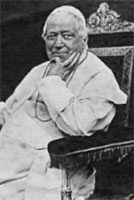
They delighted yet more by the fact that it was a Marian dogma. This attacked liberalism which by its very nature gave rise to yet another nineteenth century scourge — interconfessionalism. This scourge highlights everything religions have in common (usually a vague deism) and underrates, if not outright rejects, everything that separates them. Thus, the open or secret interconfessionalists of 1854 saw this proclamation of a new Marian dogma (like the definition of the Assumption much later) as a serious and unexpected barrier towards achieving their goals.
The new dogma also deeply shocked the essentially egalitarian mentality of the French Revolution, which since 1789 had despotically held sway in the West. To see a mere creature elevated so far above all others, enjoying an inestimable privilege from the very first instance of her conception is something that could not and cannot fail to hurt the children of a Revolution which proclaimed absolute equality among men as the basis of all order, justice and goodness. It was painful for both non-Catholics and Catholics, more or less infected with this spirit, to accept the fact that God established in creation and highlighted such outstanding inequality.
Finally, liberals dislike the nature of that privilege as such. Indeed, anyone who admits the existence of Original Sin, with all the spiritual disorders and miseries of the body that it entails, must accept that man needs an authority that he must obey. The definition of the Immaculate Conception was an implicit reaffirmation of Church teaching in this matter.
However important all these points may be, there is yet another that we would dare call the very “salt” of the dogma’s glorious definition. It is impossible to think about the Immaculate Virgin Mary without recalling how she triumphantly and definitively crushed the serpent’s head under her heel. The Revolutionary mentality is the mentality of the devil himself. A person of faith cannot fail to recognize the role the devil has played in the rise and propagation of the errors of the Revolution, from the religious disasters of the sixteenth century to the political debacle of the eighteenth century and all that followed.
For the devil to see such a triumphal affirmation of his longstanding and inflexible enemy was his most horrible humiliation. Hence, the proclamation must have given rise to an uproar of human voices and satanic howls like an immense and thunderous storm all over the world. For true Catholics, watching the intrepid and majestic figure of the Vicar of Christ standing alone against that tempest of unruly passions, threatening hatreds and furious despair, armed only with heavenly assistance, caused a jubilation like the one the Apostles felt during the storm on the Sea of Genesareth when the Savior commanded the winds and the sea to be calm: “venti et mare oboediunt ei” (Mt. 8:27).
* * *
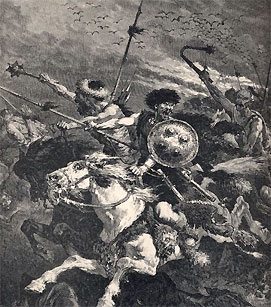
Just as all the generals and governors of the Roman Empire dispersed before the advancing Huns, so also countless Catholics at the time who should have defended the Church and Christian civilization in temporal society found themselves in a deplorable state of defeat.
In that dramatic and solemn situation, Pius IX, like Saint Leo the Great, was the only one to confront the adversary and make him retreat.
* * *
Retreat? This sounds like a daring statement, but it is the plain truth. From 1854 onward, the Revolution began to suffer great defeats.
There is no doubt the Revolution continued to extend its empire over the earth. Egalitarianism, sensuality and skepticism attained ever more radical and widespread victories. However, something new appeared. And this something, while seemingly insignificant and self-effacing, is growing irresistibly and will end up killing the Revolution.
In order to understand well this fundamental point, one must have in mind the role of the Church in history and the role of the devotion to Our Lady in the Church.
In the plans of God, the Church is the center of history. She is the Mystical Spouse of Christ whom He loves with a unique and perfect love and to whom He willed to subject all creatures. Obviously He will never abandon His Spouse and is extremely zealous of Her glory.
Thus, in the spiritual sphere, the Church has nothing to fear as long as Her human component remains faithful to Our Lord Jesus Christ: even the most severe persecutions will serve Her glory, and neither great honors nor prosperity will dampen the sense of duty and love of the Cross among the faithful.
In the temporal sphere, if men open their souls to the influence of the Church, the road will be lead to all prosperity and grandeur. On the contrary, if they abandon the Church, they will be on the path to every catastrophe and abomination. There is only one normal order of things for a people who belong to the Church: Christian civilization. And the vital principle of Christian civilization, superior to all others, is the Catholic Religion.
Conditions for the Church to Flourish
There are three essential conditions for the Church to flourish. First and foremost is Eucharistic piety. Our Lord, present in the Blessed Sacrament, is the sun of the Church. From Him come all graces. However, these graces necessarily pass through Mary, the Universal Mediatrix through whom we go to Jesus and through whom Jesus comes to us. Thus, an intense, lucid and filial Marian devotion is the second condition for virtue to flourish. While Our Lord does not speak to us in the Blessed Sacrament, He makes his voice heard through the Pope. Hence docility to the Successor of Saint Peter is the proper and logical fruit of devotion to the Holy Eucharist and to Our Lady.
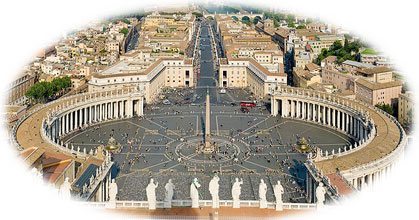
When these three devotions flourish, sooner or later the Church triumphs. When they decline, sooner or later Christian civilization decays.
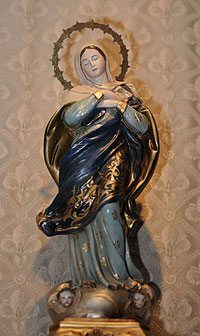
The Immaculate Conception
At the time of Lourdes, Catholic circles in Europe and the Americas had long suffered from a real religious leprosy, Jansenism. This heresy sought to weaken the Church by undermining devotion to the Holy Eucharist under the pretext of a false respect. Its proponents imposed so many conditions for a person to go to Communion that unfortunately a large number of people under its influence practically stopped receiving Our Lord. On the other hand, Jansenists carried out a relentless campaign against devotion to Our Lady, which they said deviated people from Jesus Christ rather than leading them to Him. Finally, the heresy promoted an incessant campaign against the Papacy and especially papal infallibility.
The definition of the dogma of the Immaculate Conception was the first of the great setbacks suffered by this internal enemy. Indeed, it gave rise to a huge wave of Marian piety, which has been increasingly growing.
To prove that everything comes to us through Mary, Divine Providence willed that its first great triumph be Our Lady’s triumph.
Lourdes
To glorify His Mother yet more, Our Lord went farther in Lourdes. As a stupendous confirmation of the dogma, He did something never seen before: He installed an ongoing, permanent sequence of miracles. Until Lourdes, miracles had happened in the Church only irregularly. However, in Lourdes, the most outstanding, scientifically proven and supernatural cures have been taking place for one hundred and fifty years as a confused and disoriented world looks on.
Infallibility
An immense yearning arose like a flame from this hotbed of faith and the definition of the Immaculate Conception. The most scholarly and best-qualified members of the Church were longing for the proclamation of the dogma of papal infallibility. The great Pius IX wanted it more than anyone else. When it was proclaimed, the definition of this dogma brought to the world a great surge in devotion to the Pope, which was a new defeat for impiety.
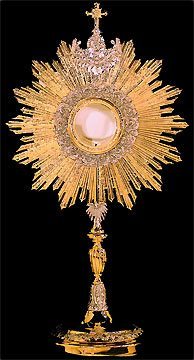
The Holy Eucharist
With the pontificate of Saint Pius X, there came an invitation for the faithful to go to Communion frequently and even daily. The great pope also encouraged children to go to Communion. Thus an era of great Eucharistic triumphs began to shine radiantly throughout the Church.
The whole Jansenist atmosphere was simply swept away from Catholic circles by these new Eucharistic norms. Not even Modernist and neo-Modernist surges that attacked the Church were able to cancel out these great victories the Church had won against Her internal adversaries.
An Immense but Frustrated Triumph
One could ask: what effect did Lourdes, the dogma proclamations and these other victories have on the struggle of the Church against her external adversaries? It would seem that the enemy is stronger than ever and that we are drawing near the era envisaged by Enlightenment thinkers centuries ago. This would be a time of crude scientific naturalism dominated by materialist technology and a one-world government with a more or less philanthropic and humanitarian orientation sweeping the last vestiges of supernatural religion from earth. Who can deny that there is not a dangerous slide of Western society toward the realization of this “ideal” today?
This slide is even closer than most people believe. However, no one seems to notice a development of primordial importance. While the world is being fashioned to fit this sinister design, it is also experiencing a profound, immense and indescribable uneasiness.
This uneasiness is an unconscious and vague malaise that remains undefined even in those aware of it. However, few would contest the reality of this discontent. One would say all humanity is suffering from a kind of violence against its nature. In response, all its wholesome fibers twist and turn as they resist. There is a longing for something else, which people still cannot define. Perhaps for the first time since the decline of Christian civilization beginning in the fifteenth century, the whole world moans in darkness and pain like the prodigal son when he reached the last degree of shame and misery away from his father’s house. At the very moment when iniquity seems to triumph, that victory seems flawed and frustrated.
Experience shows this kind of discontent often gives rise to the great surprises of history. As the twisting and turning increases, so does discontent. It is hard to tell what magnificent reactions can appear.
The hour of Divine mercy for a sinner often comes amid extreme sin and sorrow…
From our perspective, we might conclude that this promising uneasiness could well be the fruit of a resurrection of Catholic souls worked through the great events mentioned above. This resurrection has the capacity to reinvigorate all the remnants of life and sanity in all cultural areas of the world.
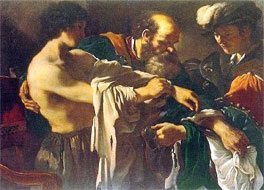
The Great Historic Moment
For the prodigal son, it certainly was a great moment in his life when his mind numbed by vice acquired a new lucidity and his will a new vigor, seeing the miserable situation in which he had fallen and the turpitude of the errors that drove him away from his father’s house. Touched by grace, he saw more clearly than ever the great alternative we faced: Either repent and return or persevere in error and accept its tragic consequences to the bitter end. All the good sentiments that his upright upbringing had planted in his soul were marvelously reborn at that providential moment. On the other hand, the tyranny of bad habits was perhaps claiming its rights more strongly than ever. An internal struggle took place, and he chose well. We all know the rest is the story, which is told in the Gospel.
Are we not drawing closer to that moment? Will all the graces gained for sinful humanity through the new surge in devotion to the Holy Eucharist, Our Lady and the papacy, produce the great conversion in our times when the tragic vicissitudes of an apocalyptic crisis seem unavoidable?
The Teaching of Lourdes
Only God knows the future. Yet it is licit for us men to make conjectures based on the rules of likelihood.
We are living a terrible time of chastisements. However, this can also turn out to be an admirable hour of mercy as long was we look to Mary, the Star of the Sea who guides us amidst the storm.
Filled with compassion toward sinful humanity, Our Lady has worked stupendous miracles for us at Lourdes for 150 years. Is that compassion now over? Could the mercy of a Mother, the best of all mothers, ever come to an end? Who would dare affirm this? Lourdes serves as an admirable lesson to anyone in doubt. Our Lady will help us.
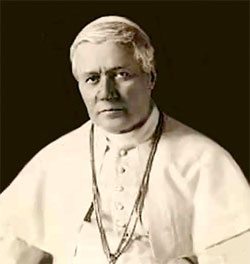
Lourdes and Fatima
She will not fail to succor us. In fact, she has already begun to help us. The definition of the dogmas of the Immaculate Conception and papal infallibility and the renewal of Eucharistic devotion continued with Marian triumphs in the pontificates that followed Saint Pius X.
Our Lady appeared at Fatima under Benedict XV. The first Fatima apparition took place precisely on the day the future Pius XII was consecrated bishop, May 13, 1917. Under Pius XI, the message of Fatima slowly but surely spread throughout the world. On that same occasion, the Holy Pontiff celebrated the 75th anniversary of the Lourdes apparitions with great jubilation, having delegated then-Cardinal Pacelli to represent him at the festivities. The pontificate of Pius XII was immortalized by the definition of the dogma of the Assumption and the Coronation of Our Lady as Queen of the World. During that pontificate, in name of Pope Pius XII, Cardinal Masella crowned a statue of the Blessed Virgin in Fatima.
These events are a brilliant trail of light going all the way from the Grotto at Massabielle at Lourdes to Cova da Iria at Fatima.
This article stops at Fatima. In her apparitions, Our Lady made it very clear: Either we convert or a tremendous chastisement will come.
However, the Reign of her Immaculate Heart will finally be established in the world. In other words, whether it be with more or less human suffering, the Heart of Mary will triumph.
This means that the days of impiety, according to the message of Fatima, are numbered. The definition of the dogma of the Immaculate Conception marked the beginning of a succession of events that will lead to the Reign of Mary.

